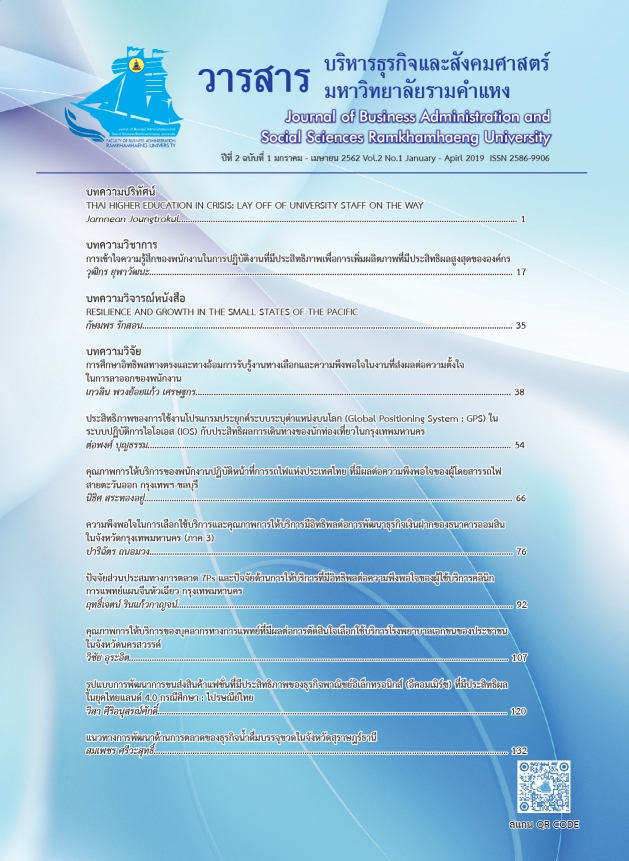THE QUALITY OF SERVICE OF THE EMPLOYEE'S DUTIES TO THE RAIL WAY AUTHORITY OF THAILAND THAT AFFECT THE SATISFACTION OF THE PASSENGERS ON RAIL LINE EAST BANGKOK – CHONBURI
Main Article Content
Abstract
This research on the quality of service of the employees’ duties to the Railway Authority of Thailand, which affect the satisfaction of the passenger rail line East, Bangkok – Chonburi, is intended to study: (1) The personal factors that can affect the quality of your service affect the satisfaction of the Eastern railway line from Bangkok to Chonburi; (2) The quality of service of the employees’ duties, which affect the satisfaction of the passengers on rail line East, Bangkok – Chonburi; and (3) The suggestions of passengers traveling on trains East from Bangkok to Chonburi, which affect their satisfaction. This research used a quantitative research methodology, employing a closed-ended survey to analyze data collected from passengers on this rail line. The population used in this study were the passengers using the rail line East, Bangkok – Chonburi. The sample employed in the study was a total of 400 people who were administered a questionnaire. The analysis of the quantitative data provided descriptive information, including mean, frequency, percentage and standard deviation and the statistics used to test the hypotheses included the independent samples t-test. The research found that passengers' personal factors affected the passengers’ satisfaction and that quality of service was significant at the 0.05 level of confidence.
Article Details
เนื้อหาและข้อมูลในบทความที่ลงตีพิมพ์ในวารสารบริหารธุรกิจและสังคมศาสตร์ มหาวิทยาลัยรามคำแหง ถือเป็นข้อคิดเห็นและความรับผิดชอบของผู้เขียนบทความโดยตรง ซึ่งกองบรรณาธิการไม่จำเป็นต้องเห็นด้วย หรือร่วมรับผิดชอบใดๆ
บทความ ข้อมูล เนื้อหา รูปภาพ ฯลฯ ที่ได้รับการตีพิมพ์ในวารสารบริหารธุรกิจและสังคมศาสตร์ มหาวิทยาลัยรามคำแหง ถือเป็นลิขสิทธิ์ของวารสารบริหารธุรกิจและสังคมศาสตร์ มหาวิทยาลัยรามคำแหง หากบุคคลหรือหน่วยงานใดต้องการนำบทความทั้งหมดหรือส่วนหนึ่งส่วนใดไปเผยแพร่ต่อ หรือเพื่อกระทำการใดๆ จะต้องได้รับอนุญาตเป็นลายลักษณ์อักษรจากวารสารบริหารธุรกิจและสังคมศาสตร์ มหาวิทยาลัยรามคำแหง ก่อนเท่านั้น
References
จิตตินันท์ นันทไพบูลย์. (2551). จิตวิทยาการบริการ. กรุงเทพฯ: ซี เอ็ดยูเคชั่น.
จินตนา บุญบงการ. (2539). การสร้างจิตสํานึกการให้บริการกับการปรับปรุงการบริการภาครัฐ. กรุงเทพฯ: ฟอร์แมทพริ้นติ้ง.
เชิดชาติ ตะโกจีน. (2559). อิทธิพลของความคาดหวังในคุณภาพการให้บริการแรงจูงใจในการใช้บริการ และ ภาพลักษณ์ของการรถไฟแห่งประเทศไทยที่มีผลต่อความตั้งใจในการใช้บริการรถไฟ โดยสารชั้น1. การค้นคว้าอิสระบริหารธุรกิจมหาบัณฑิต, มหาวิทยาลัยกรุงเทพ.
ธานินทร์ ศิลป์จารุ. (2560). การวิจัยและวิเคราะห์ข้อมูลทางสถิติด้วย SPSS และ AMOS (พิมพ์ครั้งที่ 17). กรุงเทพฯ: ห้างหุ้นส่วนสามัญบิสซิเนสอาร์แอนด์ดี.
เบญชภา แจ้งเวชฉาย. (2561). คุณภาพการให้บริการที่ส่งผลต่อความพึงพอใจของผู้โดยสารรถไฟฟ้า BTS ในกรุงเทพมหานคร. การค้นคว้าอิสระบริหารธุรกิจมหาบัณฑิต, มหาวิทยาลัยกรุงเทพ.
สุวิมล ติรกานันท์. (2551). การสร้างเครื่องมือวัดตัวแปรในการวิจัยทางสังคมศาสตร์: แนวทางสู่การปฏิบัติ. กรุงเทพฯ: โรงพิมพ์แห่งจุฬาลงกรณ์มหาวิทยาลัย.
Armstrong G., & Kotler P. (2002). Principles of Marketing (9th ed.). Prentice-Hall.
Cochran, W. G. (1953). Sampling Techniques. New York: John Wiley & Sons. Inc.
James, T. L., Calderon, E. D. V., & Cook, D. F. (2017). Exploring patient perceptions of healthcare service quality through analysis of unstructured feedback. Expert Systems with Applications, 71(4), 479-492.
Jang, S. H., Kim, R. H., & Lee, C. W. (2016). Effect of u-healthcare Service quality on usage intention in a healthcare service. Technological Forecasting and Social Change, 113(12), 396-403.
Joo, B. K., & Ready. K. J. (2012). Career satisfaction: The influences of proactive personality performance goal orientation, organizational learning culture, and leader-member exchange quality. Career Development International, 17(3), 276-295.
Millet, J. D. (1954). Management in the publics service: The quest for effective performance. New York: McGraw-Hill.
Kasiri, L. A., Cheng, K. T. G., Sambasivan, M., & Sidim, S. M. (2017). Integration of standardization and customization: Impact on service quality, customer satisfaction, and loyalty. Journal of Retailing and Consumer Services, 35(3), 91-97.
Zeithaml, V. A., Parasuraman, & L. L., Berry. (1990). Delivering Quality Service: Balancing Customer Perceptions. New York: The Free Press.
